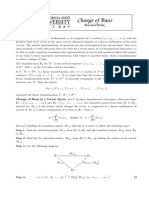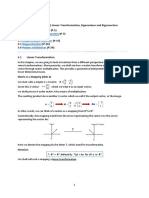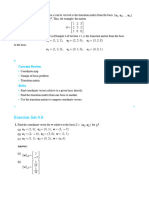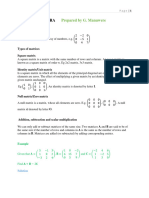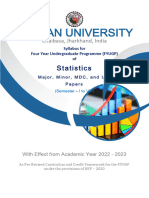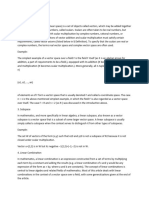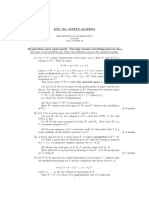Linear Algebra MA2033
Matrix form of a Linear Transformation
In this section we will show that a general linear transformation from any -dimensional vector
space to any -dimensional vector space can be performed using an appropriate matrix
transformation from to .
This idea is used in computer computations since computers are well suited for performing matrix
computations.
Suppose that is an -dimensional vector space, is an -dimensional vector space, and
is a linear transformation.
Suppose further that is a basis for , that is a basis for , and that for each vector in ,
the coordinate matrices for and are and , respectively.
It will be our goal to find an matrix such that multiplication by maps the vector into the
vector for each in .
If we can do so, we will be able to execute the linear transformation by using matrix multiplication
and the following indirect procedure:
Step 1. Compute the coordinate vector .
Step 2. Multiply on the left by to produce .
Step 3. Reconstruct from its coordinate vector .
1|Page
�Matrix form of a Linear Transformation
The key to executing this plan is to find an matrix with the property that
(1)
For this purpose, let be a basis for the -dimensional space and
be a basis for the -dimensional space .
Since Equation (1) must hold for all vectors in , it must hold, in particular, for the basis vectors in ;
that is,
[ ] [ ( )] [ ] [ ( )] (2)
But
[ ] [ ], [ ] [ ] [ ] [ ]
so
[ ]
[ ]
Substituting these results into (2) yields
[ ] [ ( )] [ ] [ ( )] [ ]
which shows that the successive columns of are the coordinate vectors of
with respect to the basis . Thus,
*[ ( )] [ ( )] + (3)
2|Page
�Matrix form of a Linear Transformation
We will call this the matrix for relative to the bases and and will denote it by the symbol .
Using this notation, Formula (3) can be written as
*[ ( )] [ ( )] + (4)
and from (1), this matrix has the property
(5)
We leave it as an exercise to show that in the special case where is multiplication by ,
and where and are the standard bases for and , respectively, then
(6)
Examples.
i. Let be the linear transformation defined by .
a. Find the matrix for with respect to the standard bases and where
Solution.
From the given formula for we obtain
( )
By inspection, the coordinate vectors for and relative to are
[ ( )] [ ],[ ( )] [ ]
Thus, the matrix for with respect to and is
*[ ( )] [ ( )] + [ ]
b. Use the three-step procedure described in the following figure to perform the computation
.
Solution.
Step 1. The coordinate matrix for relative to the basis is
* +
Step 2. Multiplying by the matrix found in Example 1 we obtain
[ ]* + [ ] [ ( )]
Step 3. Reconstructing from we obtain
3|Page
�Matrix form of a Linear Transformation
ii. Let be the linear transformation defined by
Find the matrix for the transformation with respect to the bases for and
for , where
* + * + [ ] [ ] [ ]
iii. In the special case where (so that is a linear operator), it is usual to take
when constructing a matrix for .
In this case the resulting matrix is called the matrix for relative to the basis and is usually denoted
by rather than .
If , then Formulas (4) and (5) become
*[ ( )] [ ( )] [ ( )] + (7)
(8)
In the special case where is a matrix operator, say multiplication by , and is the
standard basis for , then Formula (7) simplifies to
(9)
iv. If is a basis for a finite-dimensional vector space , and if is the
identity operator on (that is, for every vector in ), then
[ ]
v.
Theorem 1 (Matrices of Compositions ).
If and are linear transformations, and if , and are bases for , and ,
respectively, then
4|Page
�Matrix form of a Linear Transformation
The “cancellation” of interior subscripts suggests the following extension of Formula (10) to
compositions of three linear transformations:
Example.
In this example, plays the role of in Theorem 1, and plays the roles of both and ; thus we
can take in (10) so that the formula simplifies to
As a check, we will calculate directly from Formula (4).
Since , it follows from Formula (4) with and that
which agrees with (15).
5|Page
�Matrix form of a Linear Transformation
Exercises.
1) Let * + and * +, and let * + be the matrix for relative to the
basis .
(a) Find and .
(b) Find and .
(c) Find a formula for (* +).
(d) Use the formula obtained in (c) to compute (* +).
2) Let be the transformation that is defined as .
a) Show that is linear.
b) Write the matrix associated to with respect the bases
and .
3) Let be the linear transformation given by
.
Find the matrix for (i.e. ) relative to,
and ,
assuming that and are bases for and respectively.
4) Let be the vector space of functions with basis , and let be the
differential operator defined by ( ) . Compute the matrix representing in the
basis .
5) For each of the following linear transformations on , find the matrix that represents
(relative to the standard basis of ):
(a) is the rotation in counterclockwise by .
(b) is the reflection in about the line .
6) For each linear transformation defined below, find the matrix representation of relative
to the standard basis of .
a)
b) ∫
c)
7) For the following linear transformations , find a matrix such that for all
.
(a) , (* +) [ ].
(b) , satisfying (* +) * +, (* +) * +.
(c) , satisfying (* +) [ ], (* +) [ ].
6|Page





